 |
 |
 |
| |
Characteristics and risk of major adverse liver outcomes and major cardiovascular events among Swedish patients with diagnosed and high risk of metabolic dysfunction-associated steatohepatitis-a REVEAL-MASH study
High Fibrotic NASH Index Predicts 20% 10-Year Cardio Event Risk
|
| |
| |
EASL Congress 2024, June 5-8, 2004, Milan
Mark Mascolini
High liver fibrotic NASH index (FNI) predicted a 20% higher 10-year risk of major cardiovascular events in a population-wide Swedish study that included more than 162,000 people [1]. Cohort members with a high FNI had a 2-fold higher rate of major adverse cardiovascular events and a 5-fold higher rate of major adverse liver outcomes than people with a low FNI.
Researchers from Sweden's Karolinska Institute noted that the risk of metabolic-associated steatohepatitis (MASH) continues to climb worldwide. But the condition remains greatly underdiagnosed, the Karolinska team believes, and thus its actual prevalence eludes statisticians.
Answering questions about MASH and metabolic dysfunction-associated steatotic liver disease (MASLD) is tough because a noninvasive risk score cannot be derived from routinely collected patient data. The recently developed FNI, derived from a cohort of morbidly obese people in Italy and validated in Finland, Italy, and the UK in people with cardiometabolic risk factors [2], is too complex for clinical use unless simplified in a digital algorithm. The FNI has performed well in detecting high-risk of MASH with fibrosis stages 2-4 and NAFLD activity score (NAS) 4+, according to the Karolinska team. They conducted this study to see if FNI can spot people in routine clinical care who run a high risk of fibrotic MASH and to compare FNI impact on risk of major liver and cardiovascular events.
The investigators started with Swedish HERALD registry data from 1998-2022. HERALD data include all Swedish people diagnosed with liver disease according to ICD-10 codes and in specialist care with known MASH. The analysis also included 800,000 people in Stockholm during 2010-2021 who had an FNI risk score indicating high fibrosis risk (at or above 0.33) and a cardiometabolic risk factor (overweight/obesity, type 2 diabetes, hypertension, or abnormal lipids) and people in the Stockholm region in 2010-2021 at low risk for fibrotic MASH (FNI below 0.1) and with or without cardiometabolic risk factors. The analysis of high- and low-risk fibrotic MASH excluded people with any other MASH or MASLD diagnosis at any time. Those two analyses and the MASH diagnosis analysis excluded people with other liver diseases before the starting date for the analysis and people with alcohol abuse.
From across Sweden the researchers compiled a population of 615 people with a MASH diagnosis in specialist care with no other liver disease or treatment that affects the liver. The FNI population from the Stockholm area included 162,456 people with no other liver disease (including MAFLD or MASH) or treatment affecting the liver, and with cardiometabolic risk data available.
Among people with a recorded MASH diagnosis and an FNI, 84% had a high FNI (above 0.33) and only 4% had a low FNI (below 0.1). Nearly one quarter of people (23%) in routine clinical care with liver-related tests, measured high-density lipoprotein (HDL) cholesterol, and HbA1c (for diabetes) had a high FNI, while 39% of this group had a low FNI. When diagnosed with MASH, about 40% of participants had cirrhosis or a history of a major adverse liver outcome. People without a MASH diagnosis but with a high baseline FNI proved less likely to have a history of liver complications but a worse cardiovascular profile.
Among people with a high FNI but no previous liver disease, a major adverse liver outcome arose in 838 (55%) during follow-up, compared with 16% with low FNI. Incidence of a major adverse liver outcome was highest in people with diagnosed MASH (22 per 1000 person-years [p-y]) and significantly lower in people with a high FNI (4.0 per 1000 p-y, P < 0.001) and people with a low FNI (0.7 per 1000 p-y, P < 0.001 vs both other groups). Incidence of major adverse cardiovascular events was higher in people with high FNI (28 per 1000 p-y, P = 0.003 vs diagnosed MASH) and lower in people with diagnosed MASH (16 per 1000 p-y) and people with a low FNI (12 per 1000 p-y, P < 0.001 vs high FNI, P = 0.11 vs diagnosed MASH).
Cumulative 5-year risk of major adverse liver outcomes came to 10.1% in people with diagnosed MASH and 2% in those with high FNI. In contrast, 5-year risk of major adverse cardiovascular events measured 13% in people with high FNI versus 7% in those with diagnosed MASH. Hazard ratios adjusted for age, sex, type 2 diabetes, high lipids, and body mass index determined that people with diagnosed MASH had almost a 7-fold higher risk of major adverse liver outcomes than people with high FNI (adjusted hazard ratio [aHR] 6.7, 95% confidence interval [CI] 4.0 to 11.20). The high-FNI group had more than a 4-fold higher risk of major adverse liver events than the low-FNI group (aHR 4.6, 95% CI 3.9 to 5.4). People with high FNI had almost a 2-fold higher risk of major adverse cardiovascular events than people with low FNI (aHR 1.8, 95% CI 1.68 to 1.84), whereas people with diagnosed MASH did not differ significantly from the high FNI group in cardiovascular event risk (aHR 0.6, 95% CI 0.3 to 1.2).
The researchers added that 23% of all people with aspartate aminotransferase, HDL cholesterol, and HbA1c measured during routine care could be considered at high risk for fibrotic MASH. Four in 10 people with a MASH diagnosis had cirrhosis at their baseline measure, a finding the Karolinska team suggested may indicate delayed MASH diagnosis with current strategies. The 16% rate of major adverse liver events in the low FNI group at baseline points to a need for improved risk scores.
Noting that FNI can single out people at high risk for long-term major adverse liver or cardiovascular events, the investigators proposed that the measure "may be able to detect patients at earlier stage of MASH progression than the current standard of care" and may inform a new risk stratification model.
References
1. Grip ET, Apecechea NS, Basuroy R, et al. Characteristics and risk of major adverse liver outcomes and major cardiovascular events among Swedish patients with diagnosed and high risk of metabolic dysfunction-associated steatohepatitis-a REVEAL-MASH study. EASL Congress 2024, June 5-8, 2004, Milan. Abstract OS-052.
2. Tavaglione F, Jamialahmadi O, De Vincentis A, et al. Development and validation of a score for fibrotic nonalcoholic steatohepatitis. Clin Gastroenterol Hepatol. 2023;21:1523-1532. doi 10.1016/j.cgh.2022.03.044. https://www.cghjournal.org/article/S1542-3565(22)00385-8/fulltext
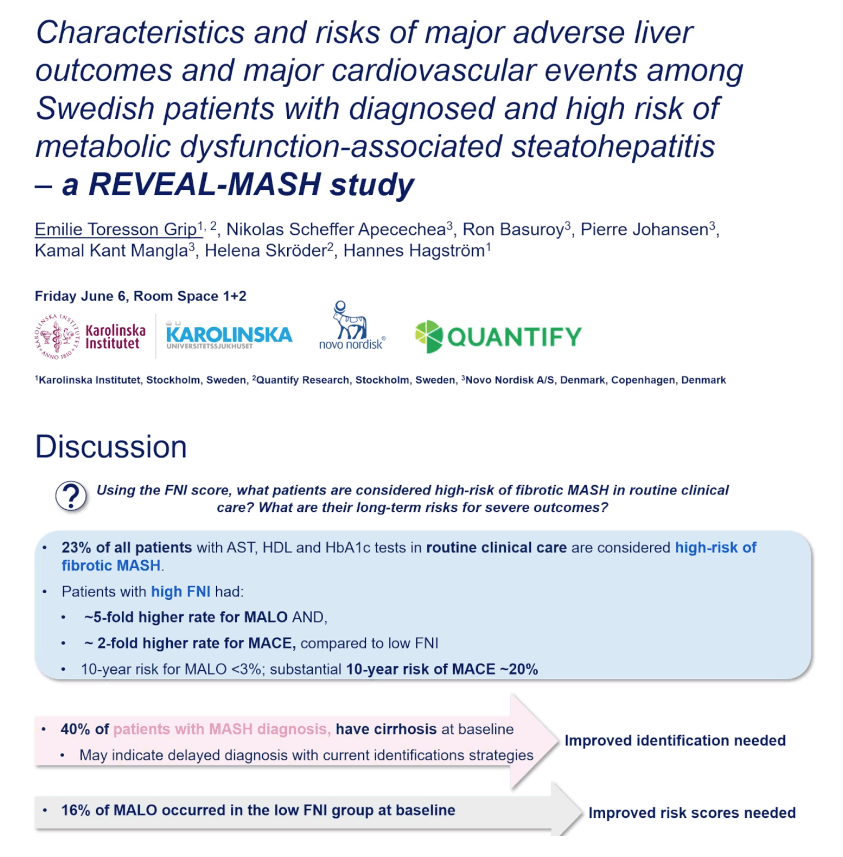
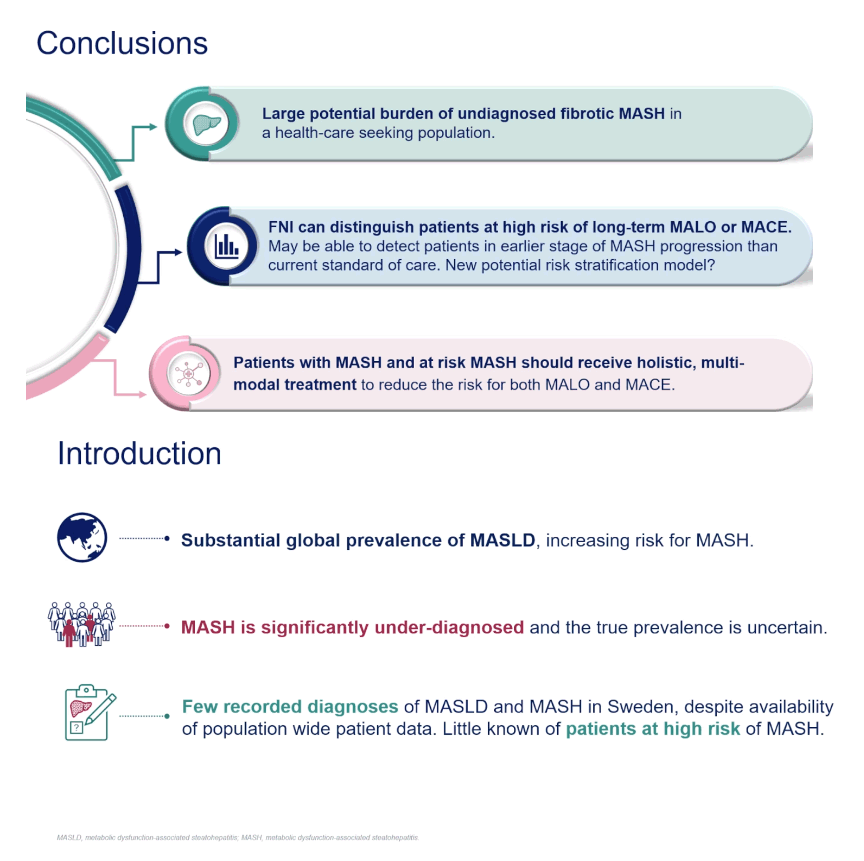
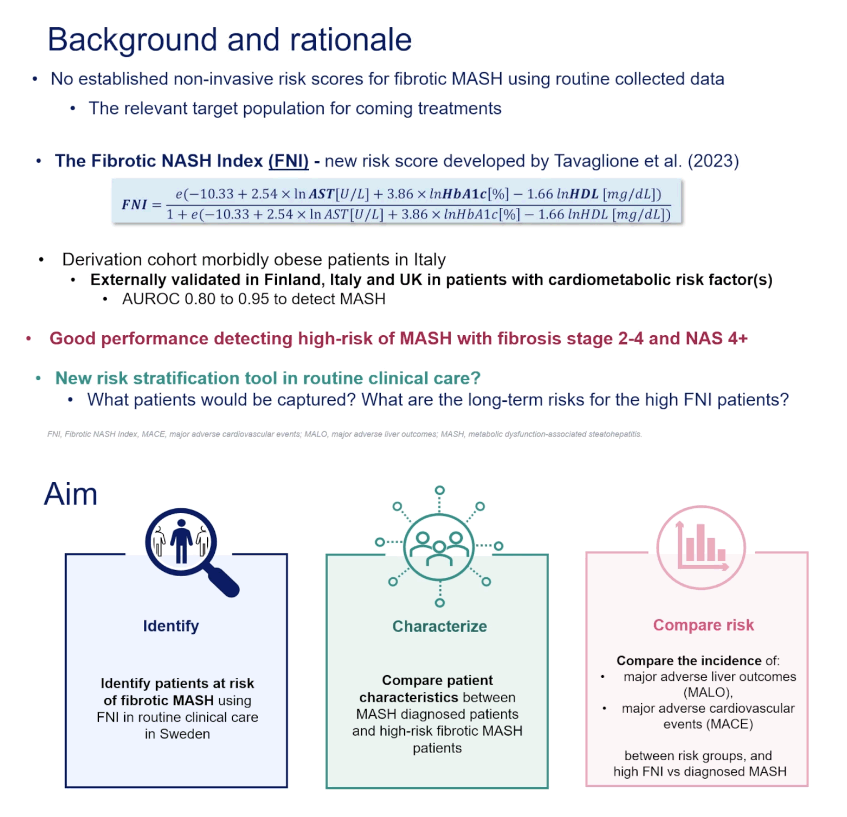
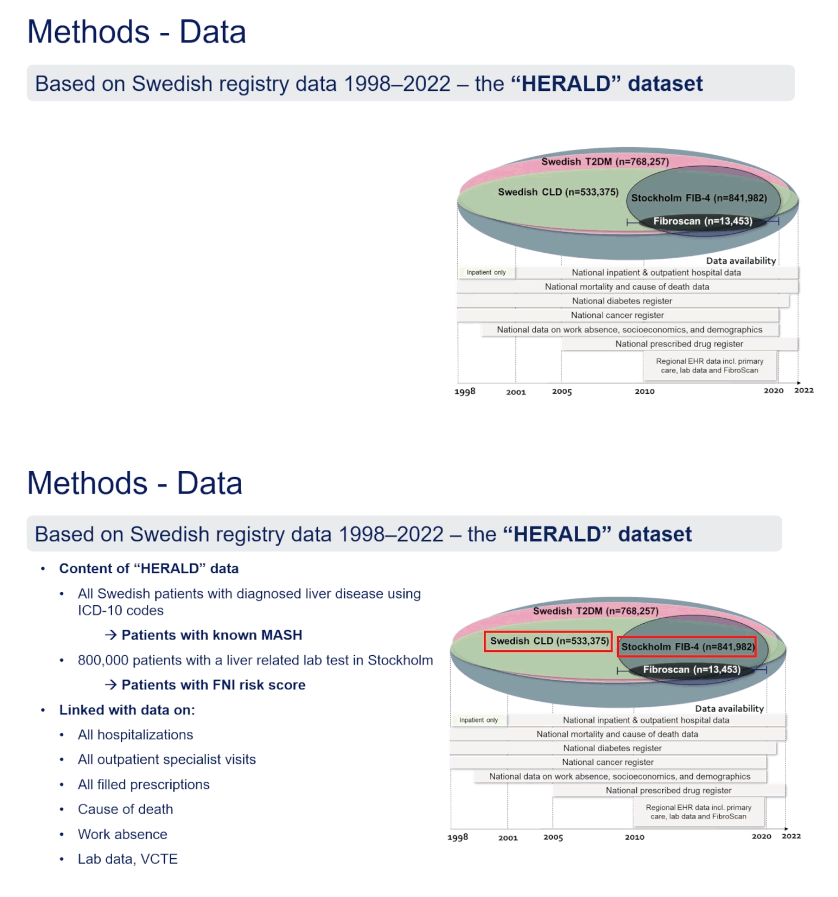
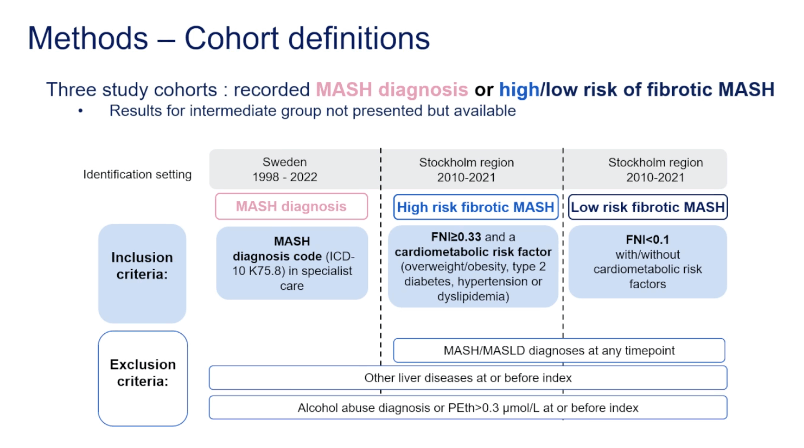
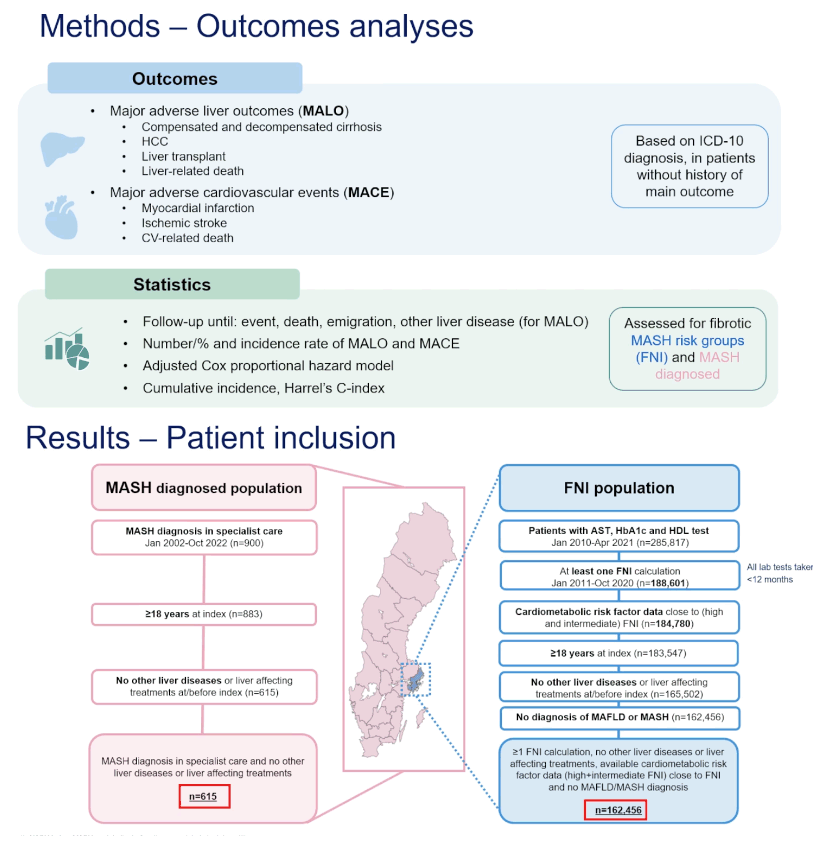
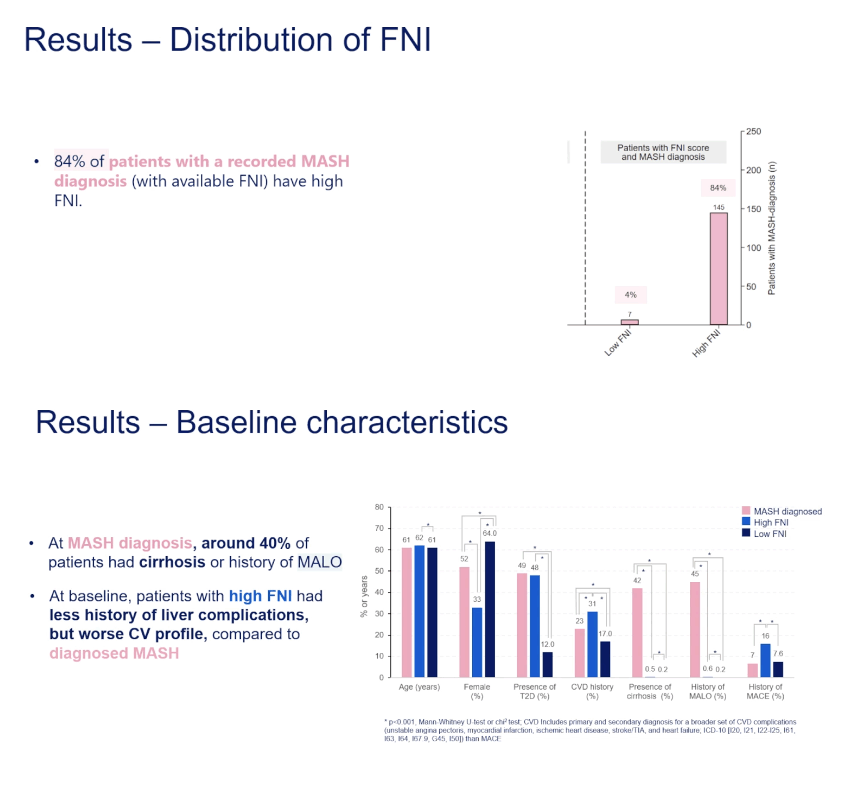
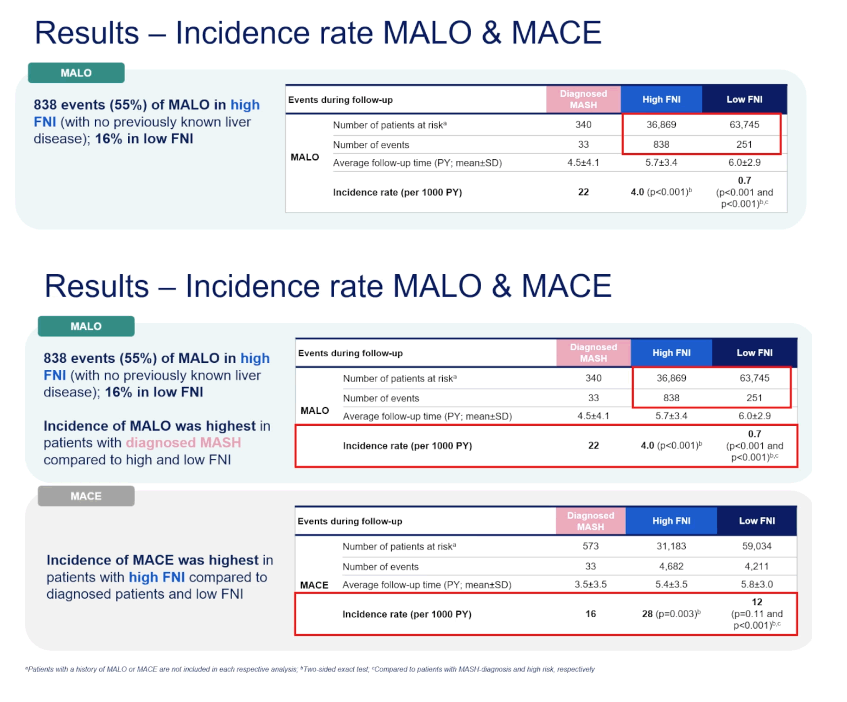
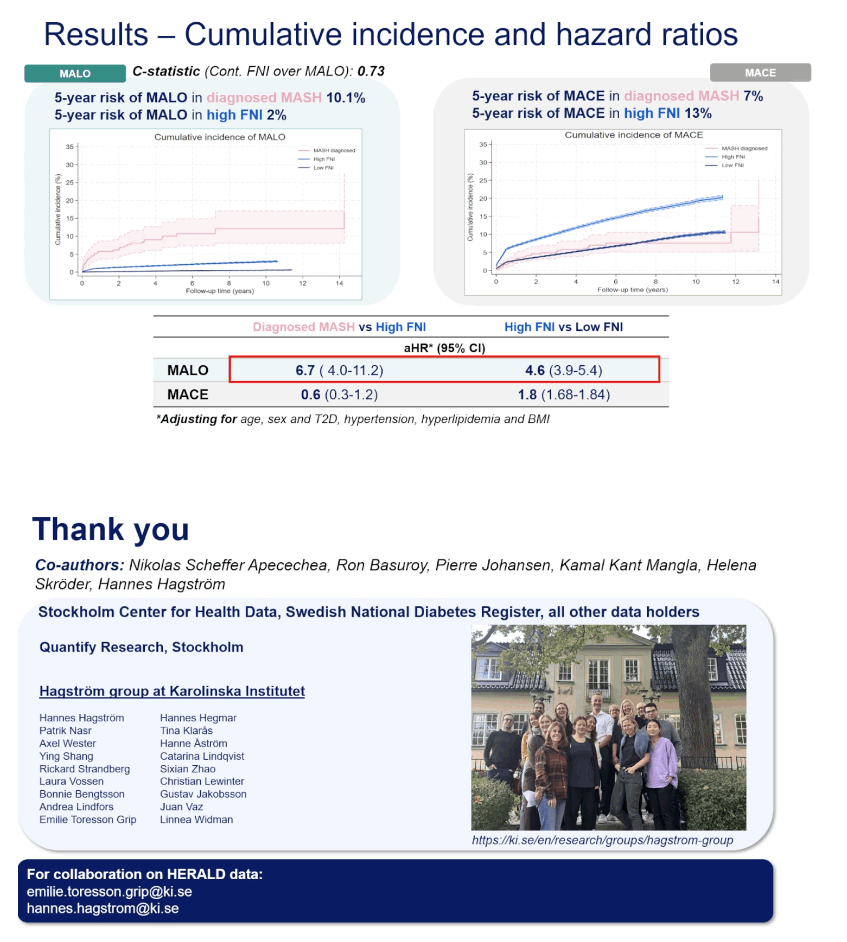
|
| |
|
 |
 |
|
|